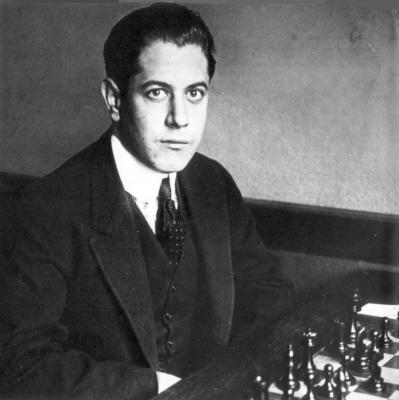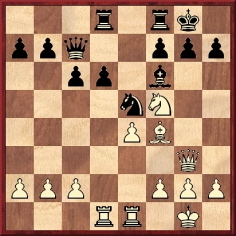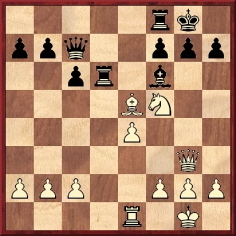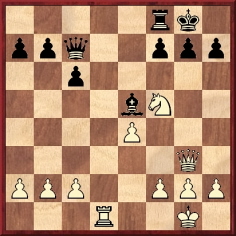
Edward Winter

José Raúl Capablanca
A number of Chess Notes items have discussed one of Capablanca’s most entertaining games, played against M. Fonaroff in New York, 1918. A digest of those items is presented here.
From page 365 of the December 1918 BCM:
‘The game below has been extensively published on both sides of the Atlantic, but we cannot resist the temptation of putting it once more into print, since it is likely to remain in chess history an example of Capablanca’s art at its prettiest level. The young Cuban brought it off at an evening entertainment of the New York Institute of Musical Art, his host and opponent being Professor Marc Fonaroff.’
The game-score and notes supplied by the BCM were as follows:
1 e4 e5 2 Nf3 Nc6 3 d4 d6 (‘An inferior defence, which enables White to turn the opening into a common form of the Steinitz Defence to the Ruy López.’) 4 Nc3 Nf6 5 Bb5 Bd7 6 O-O Be7 7 Re1 exd4 8 Nxd4 Nxd4 9 Qxd4 (‘In the standard game in this variation, Tarrasch v Schlechter, Leipzig, 1894, Tarrasch could have got the position to which this leads, but preferred 9 Bxd7+ Qxd7, before completing the exchanges in the centre.’) 9…Bxb5 10 Nxb5 O-O 11 Qc3 c6 (‘11…a6 was better, not leaving the weakness which the text-move produces.’) 12 Nd4 Nd7 (‘12…g6 would not have prevented White’s Nf5, the continuation being 12…g6 13 Bh6 Re8 14 Nf5.’) 13 Nf5 Bf6 14 Qg3 Ne5 15 Bf4 Qc7 16 Rad1 Rad8

17 Rxd6 (‘All is charming from this point, especially in view of Black’s seemingly excellent resource on his 18th move.’) 17…Rxd6 18 Bxe5

18…Rd1 (‘Of course if 18…Bxe5 19 Qxe5 wins the queen’s rook and leaves White a knight and pawn to the good.’) 19 Rxd1 Bxe5

20 Nh6+ Kh8 21 Qxe5 Qxe5 22 Nxf7+ Resigns.
The BCM appears to have been faultless in its presentation of the factual details. Pages 112-113 of The Unknown Capablanca by David Hooper and Dale Brandreth (London, 1975) quoted from the New York Evening Post of 22 June 1918:
‘A lightweight classic, that will take rank with some of Paul Morphy’s, was produced by José R. Capablanca Tuesday, when, as a guest at a soirée in the apartment of Professor Marc Fonaroff, of the New York Institute of Musical Art, he played a game of chess against that master musician. Mrs Leon Rosen … fortunately took and preserved the score for the benefit of posterity.’
A footnote in The Unknown Capablanca commented regarding the Institute: ‘This imposing title refers merely to a private school of music at 120 Claremont Avenue, NY.’ We would add that today this is the address of the Manhattan School of Music.
‘From the moment I first saw this game I fell in love with it!’, wrote Irving Chernev on page 445 of 1000 Best Short Games of Chess (New York, 1955). ‘An exquisite combination, this is one of my favourites’, he added on page 231 of Combinations The Heart of Chess (New York, 1960). ‘A magnificent game by Capablanca’, observed Roberto Grau on pages 355-356 of the December 1938 issue of El Ajedrez Americano (the longest annotations we have yet found).
Although not included in Capablanca’s Hundred Best Games of Chess by H. Golombek (London, 1947), the miniature is one of the Cuban’s most famous brilliancies. In a letter to us dated 11 February 1972 C.H.O’D. Alexander wrote: ‘I will certainly consider using it; the trouble is that it is so well known. If I don’t use it in the Sunday Times I may include it in my forthcoming (a year’s time) Penguin Book of Chess Positions.’
In fact, Alexander did not use the combination in that book, and ‘so well known’ is an accurate description. What is strange, though, is how, over time, the facts about the game have drifted away from what the New York Evening Post reported in June 1918.
La Stratégie of November-December 1918 (page 262) gave Black’s name as ‘Fanatoff’. Franz Gutmayer had such a liking for the concluding combination that it featured in at least three of his works (we use that term loosely and indulgently) of the early 1920s, each time with Black’s name given as ‘Tanaroff’:
On pages 323-324 of Schachjahrbuch 1923 by L. Bachmann (Ansbach, 1924) Gutmayer’s ‘Tanaroff’ became ‘Tanarow’, with the addition of a further error (‘played in a New York tournament’). Pages 135-136 of Homenaje a José Raúl Capablanca (Havana, 1943) had ‘N. Tanaroff’ and ‘Exhibition game, New York, 1910.’
The free-for-all marched on. ‘Fonarow’ on page 72 of Het Schaakphenomeen José Raoul Capablanca y Graupera by M. Euwe and L. Prins (The Hague, 1949). ‘Fonarov’ on page 40 of The Chess-Player’s Week-End Book by R.N. Coles (London, 1950). ‘Taneroff’, wrote Bruce Hayden on page 366 of the December 1958 Chess Review, with the date of the game given as 1910; the feature was subsequently reprinted on pages 187-189 of Hayden’s book Cabbage Heads and Chess Kings (London, 1960) with the same errors. The game also turned up again on page 361 of Chess Review, December 1960, courtesy of Jack Straley Battell (who was a Tanerowian and a 1910-ite). ‘Tannarov’ was to be found in the monograph on Capablanca by S. Petrović (Zagreb, 1974).
Confusion also grew over the correct date, with 1918 frequently elbowed aside by ‘1904’ as well as ‘1910’. Page 373 of Kings, Commoners and Knaves offered an example of how a chess writer (another lenient term here) declined to budge from his ‘1904’ even after he had been corrected. Nonetheless, the wrong dates are not recent inventions. For instance, although ‘1904’ was given on page 26 of Encyclopaedia of Chess Middlegames (Belgrade, 1980), a book published in Kecskemét in 1943 (Capablanca Sakkozói pályafutása és játszmái 1888-1942 by F. Chalupetzky and L. Tóth) had appended no date or venue to Capablanca v Fonaroff but had placed it in the juvenilia section (on page 22).
Reinfeld’s The Immortal Games of Capablanca (which had Black’s name as ‘Tanerow’) stated that the occasion was ‘New York, 1910?’. (The question mark was injudiciously removed from the 1974 edition.) The first Capablanca monograph to include the game was Glorias del Tablero “Capablanca” by José A. Gelabert (Havana, 1923). Although it proposed no date (see page 125), the order of games implied circa 1910. It need hardly be added that Capablanca published the game in none of his own books.
Then there is the discrepancy over the opening moves. Réti presented the game on pages 67-69 of his 1922 book Die Neuen Ideen im Schachspiel. (It had no heading apart from ‘Capablanca-Amateur’, although for most other games Réti furnished details of the venue and date. These were mysteriously omitted from the English translation, Modern Ideas in Chess.) Réti gave the opening moves not as 1 e4 e5 2 Nf3 Nc6 3 d4 d6 4 Nc3 Nf6 5 Bb5 Bd7 but as the more ‘natural’1 e4 e5 2 Nf3 Nc6 3 Bb5 Nf6 4 O-O d6 5 d4 Bd7. Reinfeld did the same in his book on Capablanca and commented thus on the alleged move 4…d6: ‘Black’s order of moves is a well-known finesse to avoid White’s queen-side castling, which often leads to a dangerous attack difficult for Black to parry.’ On this The Unknown Capablanca commented dryly, ‘…one annotator refers to “Black’s well-known finesse” in a position which did not, in fact, occur’.
There has also been disagreement regarding the value of Black’s 18th move:

Here, Fonaroff (aka Fonarov/Fonarow/Fanatoff/Tanaroff/Tanarow/Tannarov/Taneroff) played 18…Rd1. This ingenious rook move received two exclamation marks from Gutmayer, but already in 1920 it had been described as weaker than 18…Qa5. On page 67 of the March 1920 BCM a reader, Stefan Ólafsson of Reykjavik, wrote:
‘After 17 Rxd6 Rxd6 18 Bxe5, Black played 18…Rd1, which was not his best. Against 18…Qa5 White would perhaps win, but not so easily as he actually did.’
The BCM responded on the same page:
‘18…Qa5 is certainly better than Black’s actual move. White’s best course then seems 19 Bc3 Bxc3 20 Qxd6. If then 20…Bxe1 21 Ne7+ Kh8 22 Nxc6 Bb4 23 Qxf8+ with two pawns ahead.’
Unfortunately, this clever line does not work, because of 22…Bxf2+ 23 Kxf2 Qb6+.
At move 18 Réti gave as best for Black 18…Qa5 19 Bc3 Bxc3 20 bxc3 Rg6 21 Ne7+ ‘and White has won his pawn’. Grau offered the same line to explain why 18…Qa5 would not be an improvement. According to The Unknown Capablanca, ‘18…Qa5 would be better; White would then come out a pawn ahead after 19 f4! Bxe5 20 fxe5 Rg6 21 Ne7+’. [In C.N. 2537 Kevin Bonham pointed out that this recommendation is unsound because of 20…Qc5+, and if 21 Kh1 Rg6 White cannot play 22 Ne7+ since the queen is covering e7. Our correspondent added that the line given by Réti, 18…Qa5 19 Bc3 Bxc3 20 bxc3 Rg6 21 Ne7+, winning a pawn, therefore seems the best play for both sides.]
No detailed analysis of that critical point has yet been found, but the game continues to stimulate chess authors’ sense of fantasy. While finalizing this item, we happened to see that page 65 of Chess Training Pocket Book by Lev Alburt (New York, 2000) names Capablanca’s opponent as ‘Foxcroft’.
(2521)
Assistance kindly provided by the New York Public Library and the Juilliard School, New York enables us to present a brief biographical note on M. Fonaroff. (Not surprisingly, in the archives his forename is spelt both ‘Marc’ and ‘Mark’.)
An obituary published in Musical America of 10 January 1930 reported that he was born in Russia and went to the United States as a youth. He taught the violin in New York City from 1903 until his retirement in 1927, and he died in New York City on 19 December 1929. His wife, Vera Fonaroff, was also a violinist and teacher, at the Curtis Institute of Music in Philadelphia. The couple had two daughters, Olga and Nina.
Other records indicate that ‘Mark M. Fonaroff’ taught the violin at the Institute of Musical Art, Juilliard’s predecessor institution, from the 1906-07 academic year until the 1929-30 academic year. However, according to the unpublished appendix to Frank Damrosch’s book Institute of Musical Art, 1905-1926 (Juilliard School of Music, New York, 1936), Fonaroff did not teach after falling ill in 1928.
A brief obituary on page 4 of The Baton, volume 9, number 3 (January 1930) covered similar ground:
‘Mark Fonaroff, well-known violinist and teacher, died in Mt. Sinai Hospital on 19 December 1929. Mr Fonaroff was born in Russia and came to this country as a youth. He taught violin at the Institute of Musical Art from 1903 to 1927, when he retired. His widow, Vera Fonaroff, is a member of the Faculty of the Institute of Musical Art and of the Curtis Institute in Philadelphia.’
Vera Fonaroff died on 23 July 1962 at the age of 77. Nina
Fonaroff was formerly a dancer with the Martha Graham Company. [A
photograph of a player named Samuel Fonaroff was published on page
171 of the June 1954 Chess Review.]
(2522)
For the record, here is the full introductory text on page 11 of the New York Evening Post of 22 June 1918:
A lightweight classic that will take rank with some of Paul Morphy’s was produced by José R. Capablanca Tuesday, when, as a guest at a soirée in the apartments of Prof. Marc Fonaroff, of the New York Institute of Musical Art, he played a game of chess against that master musician. There was present a notable group of artists, including Tosha [Toscha] Seidel, the violin prodigy, who, like Mischa Elman, is very fond of chess, and Mr and Mrs Leon Rosen, who, fortunately, took and preserved the score for the benefit of posterity. The game follows.’
On a point of detail, ‘Tuesday’ would mean that the game was played on 18 June, i.e. one day later than stated in The Unknown Capablanca. It is rather curious that although Helms thought highly of the brilliancy he did not publish it in his American Chess Bulletin. Finally, Helms’ note to Black’s 18…Rd1 is intriguing:
‘A real inspiration and, against an adversary of the Cuban’s stamp, would have made of Black’s game a genuine masterpiece, except for a slight flaw. “Beautiful, but unfortunate” about expresses it, in the language of the late W.H.K. Pollock when he was wont to draw a parallel between an unsound, brilliant combination and Mary, Queen of Scots.’
This is the only time we recall seeing the ‘beautiful, but unfortunate’ remark attributed to Pollock. As noted on page 258 of Chess Explorations, we have traced it back, in relation to Janowsky, to 1898, i.e. two years after Pollock’s death.
(2592)
Black played 18…Rd1, and the question raised above is the value of the alternative move 18…Qa5. We are grateful now to Karsten Müller (Hamburg) for taking the analysis further:

‘18...Qa5! is the only move and gives Black excellent drawing chances, e.g. 19 Bc3 (19 f4?! Bxe5 20 fxe5 Qc5+ 21 Kh1 Rg6 22 Qc3 Qxc3 23 Ne7+ Kh8 24 Nxg6+ hxg6 25 bxc3 Re8 and Black even stands slightly better) 19...Bxc3 20 bxc3 Rg6 21 Ne7+ Kh8 22 Nxg6+ hxg6 23 Qd6 (23 Ra1 Kg8 24 c4 Qd2 25 Qb3 Rd8 26 h3 Rd7 draws) 23...Kg8 24 Qb4 Qxb4 25 cxb4 Rd8 and Black’s activity should be sufficient for him to draw. For example, 26 a3 Rd2 27 Rc1 Kf8 28 Kf1 Rd4 29 f3 (29 Re1 Rc4 draws) 29...Rd2, followed by …Ke7-e6.’
(2954)
We now note that on page 68 of the December 1918 Chess Amateur 18…Qa5 was described as ‘the right move … pointed out to us by Mr Gosset’. The magazine also gave the 19 f4 Bxe5 20 fxe5 Qc5+ line indicated by a correspondent in C.N. 2537.
(2962)
Addition on 24 December 2010: On page 102 of Die Hypermoderne Schachpartie by S. Tartakower (Vienna, 1924) the game was given as won by Capablanca against Tanarow in a New York tournament.
Additions can be made to the long list of misspellings of Black’s name. ‘Fonarek’ occurs in a book by a team of authors which, moreover, gave the occasion as ‘New York Budapest, 1904’: page 86 of volume one of Ajedrez integral (Havana, 2003). The misinformation was repeated when the game re-appeared on pages 172-173. On pages 189-190 of volume two (Havana, 2005) the game was presented yet again, with another misspelling: ‘Capablanca-Fonaroll Nueva York, 1904.’
(8707)
Yet another version of Black’s name can be added: Fornaroff. It appears on pages 167 and 211 of Vademecum de ajedrez by Julio Ganzo (Madrid, 1972).
(8949)
The uncertainty over the occasion of the game and Black’s identity was mentioned, with the spellings Fonarow and Tanarow, in D.J. Morgan’s Quotes and Queries column (item 2069) in the March 1970 BCM, page 78. A subsequent item (2099, on page 175 of the June 1970 BCM) stated: ‘Sir Richard Clarke tells us that Capablanca’s opponent in that simultaneous game (No. 2069, March) was Professor Aire Foncroff of the New York Institute of Musical Art.’ No explanation for this erroneous information is available.
José Raúl Capablanca A Chess Biography by M.A. Sánchez (Jefferson, 2015) gave the Capablanca v Fonaroff game on page 132. Although it was correctly dated 18 June 1918, it appeared in the section dealing with the year 1910.
To the Chess Notes main page.
To the Archives for other feature articles.
Copyright: Edward Winter. All rights reserved.